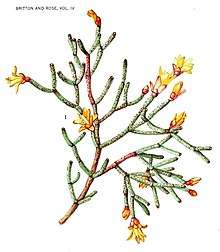Hatiora cylindrica
Hatiora cylindrica is a species of often epiphytic cactus in the tribe Rhipsalideae within the subfamily Cactoideae. It is native to east Brazil, where it grows in a variety of habitats, including moist forest, dunes and coastal rocks.
| Hatiora cylindrica | |
|---|---|
 | |
| Illustration from The Cactaceae | |
| Scientific classification | |
| Kingdom: | Plantae |
| Clade: | Tracheophytes |
| Clade: | Angiosperms |
| Clade: | Eudicots |
| Order: | Caryophyllales |
| Family: | Cactaceae |
| Subfamily: | Cactoideae |
| Genus: | Hatiora |
| Species: | H. cylindrica |
| Binomial name | |
| Hatiora cylindrica | |
| Synonyms[2][3] | |
| |
Description
Hatiora cylindrica is closely related to Hatiora salicornioides, and has been included within that species.[3] Like H. salicornioides, it is a leafless perennial with many branched green stems made up of individual segments. These are strictly cylindrical as opposed to bottle-shaped in H. salicornioides. Its flowers, borne at the end of the stems, have many yellow to orange petals and open quite widely. They are followed by white fruits.[1][4]
Taxonomy
Hatiora cylindrica was first described by Nathaniel Britton and Joseph Rose in 1923.[5] It has not always been viewed as a separate species, being included in H. salicornioides as either the form or the variety cylindrica.[2][3] Molecular phylogenetic studies have confirmed its placement in the genus and in the tribe Rhipsalideae, and also shown that it is closely related to H. salicornioides (which may include some other distinct species).[6][7]
Distribution and habitat
Hatiora cylindrica is native to Bahia in Northeast Brazil, and Minas Gerais and Rio de Janeiro in Southeast Brazil. It may also be present in Espírito Santo, also in Southeast Brazil. It is found from sea level to elevations of 1,200 m (3,900 ft). It grows as an epiphyte, in the ground and probably as a lithophyte in a variety of habitats, including humid forests, sand dunes and coastal rocks.[1]
Conservation
When assessed in 2010, it was considered to be endangered. It occurred in five localities, only one of which was protected. The main threat was a decline in its habitat caused by deforestation as a result of expanding tourism, agriculture and development.[1]
References
- Taylor, N.P. & Zappi, D. (2013), "Hatiora cylindrica", The IUCN Red List of Threatened Species 2013, International Union for Conservation of Nature, doi:10.2305/IUCN.UK.2013-1.RLTS.T152637A660008.en Missing or empty
|url=(help) - "Hatiora cylindrica Britton & Rose", Plants of the World Online, Royal Botanic Gardens, Kew, retrieved 2019-07-09
- "Hatiora cylindrica Britton & Rose", Tropicos, Missouri Botanical Garden, retrieved 2019-07-09
- Korotkova, Nadja (2011), Phylogeny and evolution of the epiphytic Rhipsalideae (Cactaceae) (PDF) (PhD thesis), Rheinischen Friedrich-Wilhems-Universität Bonn, retrieved 2019-07-09
- "Plant Name Details for Hatiora cylindrica Britton & Rose", The International Plant Names Index, retrieved 2019-07-11
- Calvente, Alice; Zappi, Daniela C.; Forest, Félix & Lohmann, Lúcia G. (2011), "Molecular phylogeny of tribe Rhipsalideae (Cactaceae) and taxonomic implications for Schlumbergera and Hatiora", Molecular Phylogenetics and Evolution, 58 (3): 456–468, doi:10.1016/j.ympev.2011.01.001, PMID 21236350
- Korotkova, Nadja; Borsch, Thomas; Quandt, Dietmar; Taylor, Nigel P.; Müller, Kai F. & Barthlott, Wilhelm (2011), "What does it take to resolve relationships and to identify species with molecular markers? An example from the epiphytic Rhipsalideae (Cactaceae)", American Journal of Botany, 98 (9): 1549–1572, doi:10.3732/ajb.1000502
